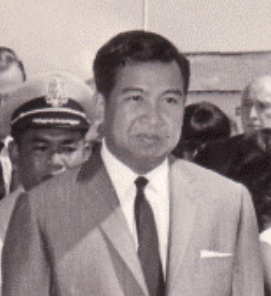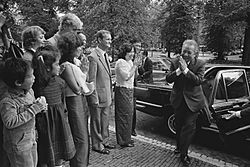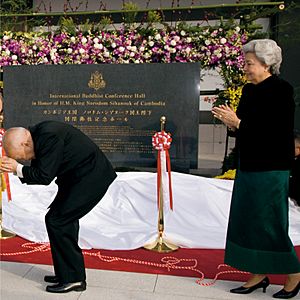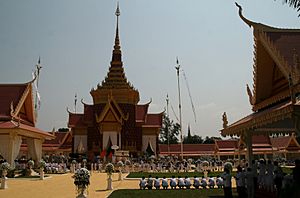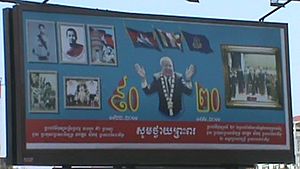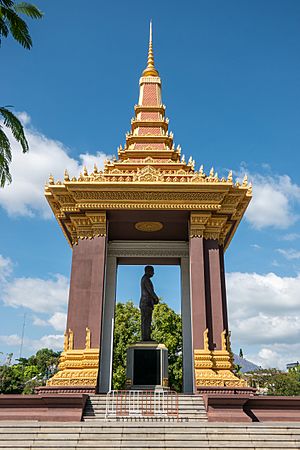Norodom Sihanouk facts for kids
Quick facts for kids Norodom Sihanouk |
|||||||||||||||||||||||||||||||||||||||||||||||||||||||||||||||||||||||||||||||||||||||||||||||||
|---|---|---|---|---|---|---|---|---|---|---|---|---|---|---|---|---|---|---|---|---|---|---|---|---|---|---|---|---|---|---|---|---|---|---|---|---|---|---|---|---|---|---|---|---|---|---|---|---|---|---|---|---|---|---|---|---|---|---|---|---|---|---|---|---|---|---|---|---|---|---|---|---|---|---|---|---|---|---|---|---|---|---|---|---|---|---|---|---|---|---|---|---|---|---|---|---|---|
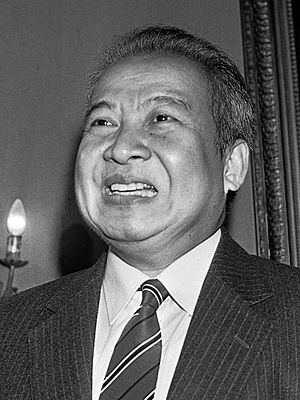
Sihanouk in 1983
|
|||||||||||||||||||||||||||||||||||||||||||||||||||||||||||||||||||||||||||||||||||||||||||||||||
| King of Cambodia | |||||||||||||||||||||||||||||||||||||||||||||||||||||||||||||||||||||||||||||||||||||||||||||||||
| First reign | 24 April 1941 – 2 March 1955 | ||||||||||||||||||||||||||||||||||||||||||||||||||||||||||||||||||||||||||||||||||||||||||||||||
| Coronation | 3 May 1941 | ||||||||||||||||||||||||||||||||||||||||||||||||||||||||||||||||||||||||||||||||||||||||||||||||
| Predecessor | Sisowath Monivong | ||||||||||||||||||||||||||||||||||||||||||||||||||||||||||||||||||||||||||||||||||||||||||||||||
| Successor | Norodom Suramarit | ||||||||||||||||||||||||||||||||||||||||||||||||||||||||||||||||||||||||||||||||||||||||||||||||
| Prime ministers |
See list
Himself
Son Ngoc Thanh Sisowath Monireth Sisowath Youtevong Sisowath Watchayavong Chhean Vam Penn Nouth Yem Sambaur Ieu Koeus Sisowath Monipong Oum Chheang Sun Huy Kanthoul Chan Nak Leng Ngeth |
||||||||||||||||||||||||||||||||||||||||||||||||||||||||||||||||||||||||||||||||||||||||||||||||
| Second reign | 24 September 1993 – 7 October 2004 | ||||||||||||||||||||||||||||||||||||||||||||||||||||||||||||||||||||||||||||||||||||||||||||||||
| Predecessor | Monarchy restored;
Himself as Chief of State
|
||||||||||||||||||||||||||||||||||||||||||||||||||||||||||||||||||||||||||||||||||||||||||||||||
| Successor | Norodom Sihamoni | ||||||||||||||||||||||||||||||||||||||||||||||||||||||||||||||||||||||||||||||||||||||||||||||||
| Prime ministers |
See list
|
||||||||||||||||||||||||||||||||||||||||||||||||||||||||||||||||||||||||||||||||||||||||||||||||
| Chief of State of Cambodia | |||||||||||||||||||||||||||||||||||||||||||||||||||||||||||||||||||||||||||||||||||||||||||||||||
| First rule | 20 June 1960 – 18 March 1970 | ||||||||||||||||||||||||||||||||||||||||||||||||||||||||||||||||||||||||||||||||||||||||||||||||
| Predecessor | Chuop Hell (acting) | ||||||||||||||||||||||||||||||||||||||||||||||||||||||||||||||||||||||||||||||||||||||||||||||||
| Successor | Cheng Heng (acting) | ||||||||||||||||||||||||||||||||||||||||||||||||||||||||||||||||||||||||||||||||||||||||||||||||
| Queen | Sisowath Kossamak | ||||||||||||||||||||||||||||||||||||||||||||||||||||||||||||||||||||||||||||||||||||||||||||||||
| Second rule | 14 June – 24 September 1993 | ||||||||||||||||||||||||||||||||||||||||||||||||||||||||||||||||||||||||||||||||||||||||||||||||
| Predecessor | Chea Sim (as President of the Council of State) | ||||||||||||||||||||||||||||||||||||||||||||||||||||||||||||||||||||||||||||||||||||||||||||||||
| Successor | Himself as King | ||||||||||||||||||||||||||||||||||||||||||||||||||||||||||||||||||||||||||||||||||||||||||||||||
| President of the State Presidium | |||||||||||||||||||||||||||||||||||||||||||||||||||||||||||||||||||||||||||||||||||||||||||||||||
| Presidency | 17 April 1975 – 2 April 1976 | ||||||||||||||||||||||||||||||||||||||||||||||||||||||||||||||||||||||||||||||||||||||||||||||||
| Predecessor | Sak Sutsakhan (as Chairman of the Supreme Committee) | ||||||||||||||||||||||||||||||||||||||||||||||||||||||||||||||||||||||||||||||||||||||||||||||||
| Successor | Khieu Samphan (as Chairman of the State Presidium) | ||||||||||||||||||||||||||||||||||||||||||||||||||||||||||||||||||||||||||||||||||||||||||||||||
| Born | 31 October 1922 Phnom Penh, Cambodia, French Indochina |
||||||||||||||||||||||||||||||||||||||||||||||||||||||||||||||||||||||||||||||||||||||||||||||||
| Died | 15 October 2012 (aged 89) Beijing, China |
||||||||||||||||||||||||||||||||||||||||||||||||||||||||||||||||||||||||||||||||||||||||||||||||
| Burial | 13 July 2014 Silver Pagoda, Royal Palace of Cambodia (interment of ashes) |
||||||||||||||||||||||||||||||||||||||||||||||||||||||||||||||||||||||||||||||||||||||||||||||||
| Spouse |
See list
Phat Kanhol
(m. 1942; div. 1946)Sisowath Pongsanmoni
(m. 1942; div. 1951)Sisowath Monikessan
(m. 1944; died 1946)Mam Manivan Phanivong
(m. 1949; div. 1955)Norodom Thavet Norleak
(m. 1955; div. 1968)Norodom Monineath
(m. 1955) |
||||||||||||||||||||||||||||||||||||||||||||||||||||||||||||||||||||||||||||||||||||||||||||||||
| Issue |
See list
Princess Buppha Devi
Prince Yuvaneath Prince Ranariddh Prince Ravivong Prince Chakrapong Prince Naradipo Princess Sorya Roeungsi Princess Kantha Bopha Prince Khemanourak Princess Botum Bopha Princess Sujata King Sihamoni Prince Narindrapong Princess Arunrasmy |
||||||||||||||||||||||||||||||||||||||||||||||||||||||||||||||||||||||||||||||||||||||||||||||||
| House | Norodom | ||||||||||||||||||||||||||||||||||||||||||||||||||||||||||||||||||||||||||||||||||||||||||||||||
| Father | Norodom Suramarit | ||||||||||||||||||||||||||||||||||||||||||||||||||||||||||||||||||||||||||||||||||||||||||||||||
| Mother | Sisowath Kossamak | ||||||||||||||||||||||||||||||||||||||||||||||||||||||||||||||||||||||||||||||||||||||||||||||||
| Religion | Theravada Buddhism | ||||||||||||||||||||||||||||||||||||||||||||||||||||||||||||||||||||||||||||||||||||||||||||||||
| Education | Cavalry School | ||||||||||||||||||||||||||||||||||||||||||||||||||||||||||||||||||||||||||||||||||||||||||||||||
| Occupation |
|
||||||||||||||||||||||||||||||||||||||||||||||||||||||||||||||||||||||||||||||||||||||||||||||||
| Political party |
|
||||||||||||||||||||||||||||||||||||||||||||||||||||||||||||||||||||||||||||||||||||||||||||||||
| Signature |  |
||||||||||||||||||||||||||||||||||||||||||||||||||||||||||||||||||||||||||||||||||||||||||||||||
|
|||||||||||||||||||||||||||||||||||||||||||||||||||||||||||||||||||||||||||||||||||||||||||||||||
Norodom Sihanouk (born October 31, 1922 – died October 15, 2012) was a very important leader in Cambodia. People in Cambodia often called him Samdech Euv, which means "King Father". He held many different roles throughout his life, including King and Prime Minister.
Cambodia went through many changes during his time. It was under French rule until 1953. Then it became an independent kingdom, a republic, and later a communist state. Finally, it became a kingdom again in 1993. Sihanouk was a key figure through all these different periods.
Sihanouk was the only child of Prince Norodom Suramarit and Princess Sisowath Kossamak. When his grandfather, King Sisowath Monivong, passed away in 1941, Sihanouk became king. This happened while Cambodia was still under French control.
After World War II, he helped Cambodia gain full independence from France in 1953. In 1955, he gave up his role as king to his father, Suramarit. This allowed him to get more directly involved in politics. His political group, Sangkum, won the elections that year, and he became Prime Minister.
Later, after his father died in 1960, Sihanouk took on a new role as Head of State of Cambodia. He tried to keep Cambodia neutral in world affairs. However, he was removed from power in 1970 and went to live in China and North Korea. He formed a group to resist the new government.
He returned to Cambodia in 1975 as a ceremonial head of state. But he resigned in 1976 and was kept under house arrest. After the Vietnamese forces overthrew the government in 1979, Sihanouk went into exile again.
In 1981, he formed a new resistance party called FUNCINPEC. He later led a group of different resistance parties. These groups worked together to try and end the Vietnamese influence in Cambodia. In 1993, Sihanouk was made King of Cambodia again. He stepped down in 2004, and his son Norodom Sihamoni became the new king. Sihanouk passed away in Beijing in 2012.
Besides being a political leader, Sihanouk was also a film director and a musician. He made many films and wrote songs throughout his life.
Contents
- Early Life and First Time as King
- The Sangkum Era
- Removed from Power and the Khmer Rouge Years
- FUNCINPEC and CGDK Years
- The UNTAC Administration and Return to Kingship
- Second Time as King
- Giving Up the Throne and Retirement
- Death and Funeral
- Sihanouk's Lasting Impact
- Creative Works
- Titles and Names
- Personal Life
- Images for kids
- See also
Early Life and First Time as King
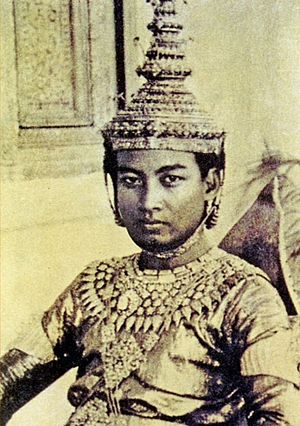
Norodom Sihanouk was the only child of Norodom Suramarit and Sisowath Kossamak. As a child, he lived with his grandmother and later his aunt. This was because of advice from a royal astrologer.
He went to school in Phnom Penh, Cambodia. His grandfather, King Sisowath Monivong, supported his hobbies. Sihanouk enjoyed sports and even had his own amateur performance group. In 1936, he went to a boarding school in Saigon.
When King Monivong died in 1941, the French chose Sihanouk to be the new king. His coronation ceremony happened on May 3, 1941. During World War II, Japan occupied Cambodia. In 1945, Sihanouk declared Cambodia's independence under Japanese pressure. He also became prime minister at the same time.
Working Towards Independence
As prime minister, Sihanouk made some changes. After Japan surrendered in 1945, the French returned to Cambodia. Sihanouk's uncle, Sisowath Monireth, helped Cambodia gain more control over its own affairs.
In 1946, Sihanouk helped create Cambodia's first constitution. This constitution allowed for an elected parliament and freedom of the press. He also traveled to France for military training.
In 1949, Sihanouk went to Paris to ask the French government for more independence. A new agreement was signed, which gave Cambodia some self-rule. However, France still controlled many important parts of the government.
Sihanouk became tired of the political arguments in Cambodia. In 1949, he decided to rule by himself for two years. He later became prime minister again in 1952. He felt that a parliamentary democracy was not working well for Cambodia at that time.
In 1953, Sihanouk went to France and then to Canada and the United States. He spoke to leaders and gave interviews. He asked for full independence for Cambodia. He explained that Cambodia faced a threat from communists. He argued that independence would help Cambodia deal with this threat.
Sihanouk returned to Cambodia in June 1953. He organized public events to encourage Cambodians to fight for independence. France eventually agreed to give Cambodia more control. On November 9, 1953, Sihanouk declared Cambodia's full independence from France.
In 1954, Cambodia attended the Geneva Conference. The agreements there confirmed Cambodia's independence. They also allowed Cambodia to get military help from any country.
The Sangkum Era
Giving Up the Throne to Join Politics
On March 2, 1955, Sihanouk surprised everyone by giving up his role as king. His father, Norodom Suramarit, became the new king. Sihanouk explained that he wanted to be a "normal citizen" to be closer to the people. This allowed him to be more active in politics.
In April 1955, Sihanouk started his own political group called the Sangkum. He said it was an "organization" rather than a political party. He wanted to bring together people with different ideas, as long as they supported the monarchy.
The Sangkum won the elections in September 1955. They won all the seats in the National Assembly. The next month, Sihanouk became prime minister.
Leading as Prime Minister (1955–1960)
As prime minister, Sihanouk made some changes to the constitution. Women were given the right to vote. Khmer became the only official language. He also made the prime minister, not the king, responsible for making policies.
He believed in a concept called "Buddhist socialism". This meant promoting social equality while keeping Cambodia's Buddhist culture. Between 1955 and 1960, Sihanouk resigned and returned to the prime minister role several times. He often said he was tired from overwork.
Sihanouk accepted military aid from the United States in 1955. However, he later suspected the US was trying to weaken his government. He developed a good relationship with China. China promised Cambodia economic aid in 1956.
Leaders from Thailand and South Vietnam, who were allies of the US, became suspicious of Sihanouk. They accused him of being too close to communist countries. South Vietnam even stopped trade ships from reaching Phnom Penh for a short time.
In 1959, Sihanouk discovered a plan to overthrow him. He sent the army to stop it. He then accused South Vietnam and the United States of being involved. Later that year, a bomb was sent to the royal palace, killing an official. This made Sihanouk distrust the US even more.
Becoming Head of State (1960–1965)

Sihanouk's father, King Suramarit, died in 1960. Sihanouk then created a new position: Head of State of Cambodia. This role had ceremonial powers similar to a king. A public vote approved this, and Sihanouk officially became Head of State in June 1960. He continued to lead his political group, Sangkum.
In 1961, Sihanouk arrested some political opponents. He claimed they were working for foreign powers. He also appointed some left-wing politicians to his government.
In 1962, Sihanouk asked the US to stop supporting a group called the Khmer Serei. He believed the US was secretly helping them. He eventually refused all economic aid from the US in 1963. He also took control of important industries like banking.
Sihanouk signed a secret agreement with North Vietnam and the Viet Cong in 1964. This allowed Chinese military aid to pass through Cambodia. The Cambodian army was paid to deliver food supplies. This led to the US bombing parts of eastern Cambodia. Sihanouk ended diplomatic ties with the US in May 1965.
Leading as Head of State (1966–1970)
In 1966, elections led to more conservative politicians in the National Assembly. They chose Lon Nol, a military general, as prime minister. Sihanouk was not happy with this. He created a "shadow government" with left-wing politicians to balance power.
In 1967, a peasant uprising happened. Sihanouk suspected some left-wing politicians had encouraged it. Some of them fled to join the Khmer Rouge.
Sihanouk's relationship with China became difficult. He accused China of spreading communist ideas in Cambodia. He even threatened to close the Chinese embassy. China's premier, Zhou Enlai, stepped in to calm things down.
As relations with China worsened, Sihanouk tried to improve ties with the US. He invited Jacqueline Kennedy, the widow of US President John F. Kennedy, to visit Cambodia. This helped open the door for talks with the US. Sihanouk hinted that he would not stop US forces from attacking Viet Cong troops who retreated into Cambodia, as long as Cambodians were not harmed.
However, the US began heavy bombing raids in eastern Cambodia in 1969. This forced Viet Cong troops into populated areas. Sihanouk became worried Cambodia would be drawn into the Vietnam War. He recognized the Provisional Revolutionary Government of South Vietnam. This was to try and get Viet Cong troops to leave Cambodia. He also admitted for the first time that Viet Cong troops were in Cambodia. This led the US to restore diplomatic relations with Cambodia.
To help Cambodia's economy, Sihanouk opened casinos in 1969. While they made money, they also caused many people to go bankrupt. In August 1969, Lon Nol became Prime Minister again. Sihanouk left Cambodia for medical treatment in France in January 1970.
Removed from Power and the Khmer Rouge Years
The 1970 Coup
In January 1970, Sihanouk was on holiday in France. On March 11, protests happened outside the North Vietnamese and South Vietnamese embassies in Cambodia. Protesters demanded that Viet Cong troops leave Cambodia. The protests became violent, with embassies being looted and set on fire.
Sihanouk was in Paris and decided to visit Moscow, Beijing, and Hanoi. He hoped to convince their leaders to recall Viet Cong troops. However, on March 18, 1970, the National Assembly voted to remove Sihanouk from power. Lon Nol took over with emergency powers.
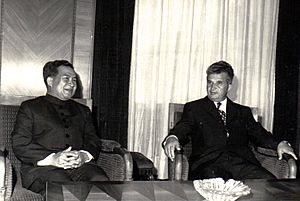
Sihanouk was in Moscow when he heard the news. He then flew to Beijing, where Chinese leaders welcomed him. They told him China still saw him as Cambodia's rightful leader. They promised him military and financial support.
A Difficult Alliance
On March 23, 1970, Sihanouk announced he was forming a resistance movement. He encouraged Cambodians to fight against Lon Nol's government. Many Cambodian peasants deeply respected Sihanouk. His call for resistance had a big impact.
On May 5, 1970, Sihanouk announced a government-in-exile called the Royal Government of the National Union of Kampuchea (GRUNK). Many communist countries supported this government. In Phnom Penh, Sihanouk was charged with treason and corruption. He was sentenced to death in his absence.
From 1970 to 1975, Sihanouk lived in guesthouses in Beijing and Pyongyang. In 1973, he traveled through parts of Cambodia with Khmer Rouge leaders. He saw the effects of American bombing during this trip.
After the Khmer Republic fell to the Khmer Rouge in April 1975, a new government called Democratic Kampuchea was formed. Sihanouk was made its Head of State, but it was mostly a ceremonial role. He briefly returned to Cambodia in September 1975. He then traveled abroad to gain support for the new government.
He returned to Cambodia in December 1975. In February 1976, he toured the countryside. He was shocked to see forced labor and people being moved from their homes by the Khmer Rouge. After this, Sihanouk decided to resign as Head of State. His resignation was accepted in April 1976.
Under House Arrest
After resigning, Sihanouk was kept under house arrest at the royal palace. He tried several times to travel overseas but was not allowed. In December 1978, Vietnam invaded Cambodia. On January 6, 1979, Sihanouk was allowed to fly to Beijing.
The next day, Phnom Penh fell to Vietnamese troops. Sihanouk then went to New York to speak at the UN Security Council. He spoke out against both the Khmer Rouge and the Vietnamese occupation of Cambodia. He later sought safety in China.
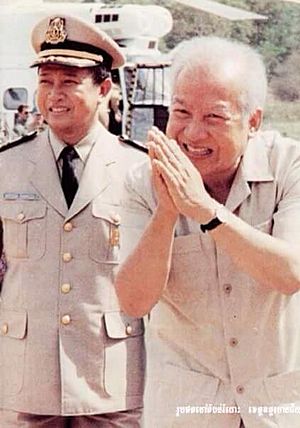
FUNCINPEC and CGDK Years
Leading the Resistance
After the Khmer Rouge government was overthrown, a new Cambodian government supported by Vietnam was set up. China's leader, Deng Xiaoping, wanted Sihanouk to work with the Khmer Rouge to overthrow this new government. Sihanouk did not want to, because he opposed the Khmer Rouge's terrible actions.
In March 1981, Sihanouk started a resistance movement called FUNCINPEC. It had a small army. China offered military help if Sihanouk worked with the Khmer Rouge. Sihanouk reluctantly agreed. He began talks with the Khmer Rouge and another group to form a united resistance.
Negotiations for Peace
After many discussions, FUNCINPEC, the Khmer Rouge, and another group formed the Coalition Government of Democratic Kampuchea (CGDK) in June 1982. Sihanouk led this government-in-exile. The United Nations recognized Sihanouk as Cambodia's international head of state.
As the CGDK leader, Sihanouk tried to negotiate an end to the Vietnamese occupation. He appointed two of his sons, Norodom Chakrapong and Norodom Ranariddh, to lead his army.
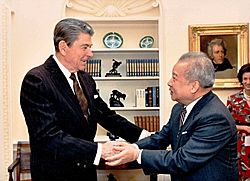
In December 1987, Sihanouk met with Hun Sen, the Prime Minister of the Vietnamese-backed government. They discussed ending the war. Later, in 1988 and 1989, more meetings were held in Jakarta, Indonesia, between the different Cambodian groups.
In July 1989, the Paris Peace Conference began. Discussions focused on Vietnamese troop withdrawal and how a future Cambodian government would share power. In September 1990, the United Nations (UN) helped create the Supreme National Council of Cambodia (SNC). This group would oversee Cambodia's affairs until UN-backed elections. Sihanouk was elected as its leader in July 1991.
The UNTAC Administration and Return to Kingship
Peace Accords and Coming Home
On October 23, 1991, Sihanouk and the different Cambodian groups signed the Paris Peace Accords. These agreements recognized the SNC as Cambodia's official representative. They also created the United Nations Transitional Authority in Cambodia (UNTAC). UNTAC was a temporary government that would help disarm troops and organize national elections by 1993.
Sihanouk returned to Phnom Penh on November 14, 1991. Many people lined the streets to welcome him back. UNTAC began its work in February 1992. However, the Khmer Rouge refused to cooperate with disarmament. Sihanouk urged UNTAC to continue without them.
Sihanouk mostly lived in Siem Reap during this time. He also traveled to Beijing for medical treatment. While there, he suggested a new type of government for Cambodia, but later dropped the idea.
Elections and Becoming King Again
In the 1993 elections, Sihanouk's son, Norodom Ranariddh, led FUNCINPEC to victory. Hun Sen's party came in second. Hun Sen's party was not happy with the results.
Sihanouk tried to form a temporary government with Hun Sen and Ranariddh as his deputies. However, Ranariddh and other countries opposed this plan. Sihanouk then changed his mind.
On June 14, 1993, Sihanouk was officially reinstated as the head of state. The 1970 coup that removed him was declared "illegal." As Head of State, Sihanouk renamed the Cambodian military and the country itself. He also brought back the old national anthem and flag.
Sihanouk appointed Ranariddh and Hun Sen as co-prime ministers with equal power. This was a temporary arrangement. On September 21, 1993, a new constitution was approved. It made Cambodia a constitutional monarchy with a king.
Second Time as King
Restored Monarchy and Political Influence
The new constitution began on September 24, 1993. Sihanouk was officially made King of Cambodia again. A new government was formed with FUNCINPEC, Hun Sen's party, and another party. Sihanouk made Ranariddh and Hun Sen First and Second Prime Ministers.
Soon after, Sihanouk went to Beijing for cancer treatment. When he returned in 1994, he suggested holding new elections to include the Khmer Rouge in the government. Both Ranariddh and Hun Sen rejected this idea. Sihanouk felt frustrated that his suggestions were being ignored. This showed that the king's power over national affairs had lessened.
In July 1994, one of Sihanouk's sons, Norodom Chakrapong, tried to overthrow the government. Sihanouk helped negotiate for his son to go into exile. Later, another relative was accused of plotting against Hun Sen. Sihanouk intervened to protect him and helped him go into exile in France.
Relations between the two co-prime ministers, Ranariddh and Hun Sen, became difficult. Sihanouk tried to ease tensions between their parties. In March 1997, Sihanouk said he was willing to give up the throne again. He felt that anti-royalist feelings were threatening the monarchy. Hun Sen warned him that if he did, royal family members might be banned from politics.
In July 1997, fighting broke out between the parties of Ranariddh and Hun Sen. Ranariddh was removed from power. Sihanouk was unhappy but did not call it a "coup." He again offered to abdicate, but it did not happen.
In September 1998, Sihanouk helped mediate political talks after protests about the 1998 elections. The talks broke down after an assassination attempt on Hun Sen. Two months later, Sihanouk helped broker another agreement for a coalition government.
Final Years as King
Sihanouk kept a monthly bulletin where he wrote about politics and shared old photos. He sometimes used a character named "Ruom Rith" to express critical comments about the government. Hun Sen was offended by this and asked Sihanouk to stop.
In 2002, Sihanouk worried about the rules for choosing a new king. When Hun Sen dismissed his concerns, Sihanouk threatened to abdicate. This was to force the royal council to choose a new monarch.
In 2003, elections were held again. Hun Sen's party won but did not get enough seats to form a government alone. The other parties blocked them. Sihanouk urged the parties to work together. He even said he would not attend the swearing-in ceremony if they did not cooperate.
In February 2004, Sihanouk publicly supported same-sex marriage. This was a very progressive stance at the time in Cambodia. Sihanouk also started the "Samdech Euv Team" to help with humanitarian work across the country.
Giving Up the Throne and Retirement
On July 6, 2004, Sihanouk announced his plans to abdicate again. He criticized Hun Sen and Ranariddh for ignoring his advice. Hun Sen and Ranariddh agreed to change a law about voting for ministers. Sihanouk did not approve of this change.
On October 6, 2004, Sihanouk wrote a letter asking the royal council to choose a successor. The National Assembly and Senate quickly passed laws to allow the king to abdicate. On October 14, 2004, the royal council chose Norodom Sihamoni as Sihanouk's successor. Sihamoni was crowned King of Cambodia on October 29, 2004.
In March 2005, Sihanouk accused neighboring countries of taking Cambodian land. He formed a council to deal with border issues. However, Hun Sen created a separate body for this. After Hun Sen signed a border treaty with Vietnam, Sihanouk dissolved his council.
In 2007, there was a call for Sihanouk to testify in a court about the Khmer Rouge. Sihanouk invited the court's officer to discuss his experiences. Both Hun Sen and Sihanouk's former party criticized this idea. The court did not accept Sihanouk's invitation.
In 2008, a border dispute arose between Thailand and Cambodia. Sihanouk issued a statement supporting Cambodia's claim to a temple. In 2009, Sihanouk said he would stop posting on his website because he was getting old. From 2009 to 2011, he spent most of his time in Beijing for medical care. He made his last public appearance in Phnom Penh on his 89th birthday in October 2011. He returned to Beijing for more treatment in January 2012.
Death and Funeral
In January 2012, Sihanouk wrote a letter saying he wanted his body to be cremated after his death. He wished for his ashes to be placed in a golden urn. On October 15, 2012, Sihanouk died of a heart attack in Beijing.
When the news broke, King Sihamoni, Hun Sen, and other officials flew to Beijing. The Cambodian government announced seven days of mourning. State flags were flown at one-third height. Two days later, Sihanouk's body was brought back to Cambodia. About 1.2 million people lined the streets to see his procession.
Sihanouk's funeral and cremation were held in February 2013. His body lay in state at the royal palace for three months. A long street procession was held, and his body was cremated on February 4, 2013.
The next day, some of Sihanouk's ashes were scattered into the Tonle Sap river. The rest were kept in the palace. In October 2013, a statue of Sihanouk was unveiled near the Independence Monument. In July 2014, his ashes were placed in the Silver Pagoda.
Sihanouk's Lasting Impact
Sihanouk was a central figure in Cambodian public life for over 60 years. He held many different roles and was one of the most important leaders in modern Cambodian history. A journalist once said that "No monarch in modern times has embodied the life and fate of his country so completely as Norodom Sihanouk."
He even holds a Guinness World Record for "Most state roles held by a modern royal." He served as king, prime minister, head of state, regent, and more.
People saw Sihanouk as a very charming leader. His legacy is complex, with both successes and challenges. He is remembered as the "father of Cambodian independence" for his efforts to free Cambodia from French rule.
However, his brief alliance with the Khmer Rouge after he was removed from power in 1970 affected his reputation. It is believed that Sihanouk did not know about the Khmer Rouge's terrible plans. He was also affected by their rule, being put under house arrest, and losing family members. Sihanouk later spoke out against the Khmer Rouge's actions.
Despite the difficulties, Sihanouk represented stability for Cambodians. He was seen as a "God king" and a unifying figure. People valued his warmth and care for his people, even with his mistakes. His life is often seen as a reflection of Cambodia's own difficult history. He was truly devoted to his country.
Creative Works
Film-making
Sihanouk made about 50 films during his life. He loved movies from a young age. After becoming king in 1941, he made amateur films. He even sent Cambodian students to France to study film-making.
In 1965, he was unhappy with how Cambodia was shown in a movie called Lord Jim. So, he made his first feature film, Apsara, in 1966. He went on to make and act in many more films. He often included members of the royal family and military generals in his movies.
Sihanouk said he made films to show Cambodia in a good way. His films often had themes of national pride. Some people said his films were not very artistic.
In 1967, one of his films was nominated at a film festival in Moscow. In 1968, Sihanouk started the Phnom Penh International Film Festival. He was the only winner of a special award there. He stopped making films after he was removed from power in 1970, but started again in 1987.
In 1997, he received a special award at the Moscow International Film Festival. He said he had a budget of $20,000 to $70,000 for each film. In 2006, he made his last film, Miss Asina. He announced his retirement from film-making in May 2010.
Music
Sihanouk wrote at least 48 songs between the late 1940s and early 1970s. He mixed traditional Khmer music with Western styles. His early songs were often about love and patriotism. He wrote romantic songs for his wife, Monique.
He also wrote songs to show the beauty of Cambodian towns. These songs helped create a sense of national unity. Some of his songs were about neighboring countries.
After he was removed from power in 1970, Sihanouk wrote songs that praised communist leaders. These songs showed his thanks for their support. Sihanouk learned to play several instruments, including the clarinet, saxophone, piano, and accordion.
In the 1960s, Sihanouk led a band with his relatives. They performed French songs and his own music for diplomats. When he toured Cambodian provinces, he was joined by the Royal Military Orchestra and pop singers. Even when he was in exile, he held concerts for diplomats. After he became king again in 1993, he continued to perform occasionally at the royal palace.
Titles and Names
| Styles of King Norodom Sihanouk of Cambodia |
|
|---|---|
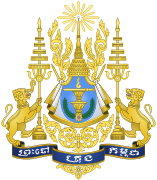 |
|
| Reference style | His Majesty |
| Spoken style | Your Majesty |
Sihanouk was known by many different titles. He holds a Guinness World Record for holding the most different state and political jobs. When he became king in 1941, his official title was "Preah Bat Samdech Preah Norodom Sihanouk Varman." He used this title during both his times as king.
After he gave up the throne in 1955, his father gave him the title "Samdech Preah Upayuvareach," meaning "The Prince who has been King." From the 1960s, when he became Head of State, many Cambodians lovingly called him "Samdech Euv," which means "Prince Father."
In 2004, after his second time giving up the throne, he became known as the King Father of Cambodia. He also asked to be called "Samdech Ta" (Grandfather) or "Samdech Ta-tuot" (Great-grandfather). When he died in 2012, his son gave him a special title meaning "The King who lies in the Diamond Urn."
Personal Life
Sihanouk's name comes from two ancient words meaning "Lion" and "Jaws." He spoke Khmer, French, and English very well. In high school, he enjoyed sports like football, basketball, volleyball, and horse riding.
He had health issues, including diabetes and depression. In 1993, he was diagnosed with a type of cancer and received treatment. He had periods of remission, but the cancer returned a few times.
In 1960, Sihanouk built a home in Phnom Penh. After he was removed from power in 1970, he lived in guesthouses in Beijing. In 1974, North Korean leader Kim Il-sung built a large mansion for Sihanouk. Sihanouk enjoyed taking boat trips there and even filmed movies on the property.
In 2008, Sihanouk shared his assets online. He said he owned a small house and some savings. He also clarified that his homes in Beijing and Pyongyang were guesthouses owned by those governments, not by him.
Family

Sihanouk had several marriages. His most important and lasting marriage was to Paule Monique Izzi, who later changed her name to Monineath. She was his lifelong partner.
Sihanouk had fourteen children with five different wives. During the Khmer Rouge years, five of his children and fourteen of his grandchildren disappeared. Sihanouk believed they were killed by the Khmer Rouge.
Here are his children:
| Name | Year of birth | Year of death | Mother | Cause of death |
|---|---|---|---|---|
| Norodom Buppha Devi | 1943 | 2019 | Phat Kanhol | |
| Norodom Yuvaneath | 1943 | 2021 | Sisowath Pongsanmoni | |
| Norodom Ranariddh | 1944 | 2021 | Phat Kanhol | |
| Norodom Ravivong | 1944 | 1973 | Sisowath Pongsanmoni | Malaria |
| Norodom Chakrapong | 1945 | Sisowath Pongsanmoni | ||
| Norodom Naradipo | 1946 | 1976 | Sisowath Monikessan | Disappeared under Khmer Rouge |
| Norodom Sorya Roeungsi | 1947 | 1976 | Sisowath Pongsanmoni | Disappeared under Khmer Rouge |
| Norodom Kantha Bopha | 1948 | 1952 | Sisowath Pongsanmoni | Leukemia |
| Norodom Khemanourak | 1949 | 1975 | Sisowath Pongsanmoni | Disappeared under Khmer Rouge |
| Norodom Botum Bopha | 1951 | 1975 | Sisowath Pongsanmoni | Disappeared under Khmer Rouge |
| Norodom Sujata | 1953 | 1975 | Mam Manivan | Disappeared under Khmer Rouge |
| Norodom Sihamoni | 1953 | Monique Izzi (Monineath) | ||
| Norodom Narindrapong | 1954 | 2003 | Monique Izzi (Monineath) | Heart attack |
| Norodom Arunrasmy | 1955 | Mam Manivan |
Images for kids
-
Carlos P. Garcia, the then-Vice President of the Philippines in 1956 with Sihanouk
See also
 In Spanish: Norodom Sihanouk para niños
In Spanish: Norodom Sihanouk para niños



